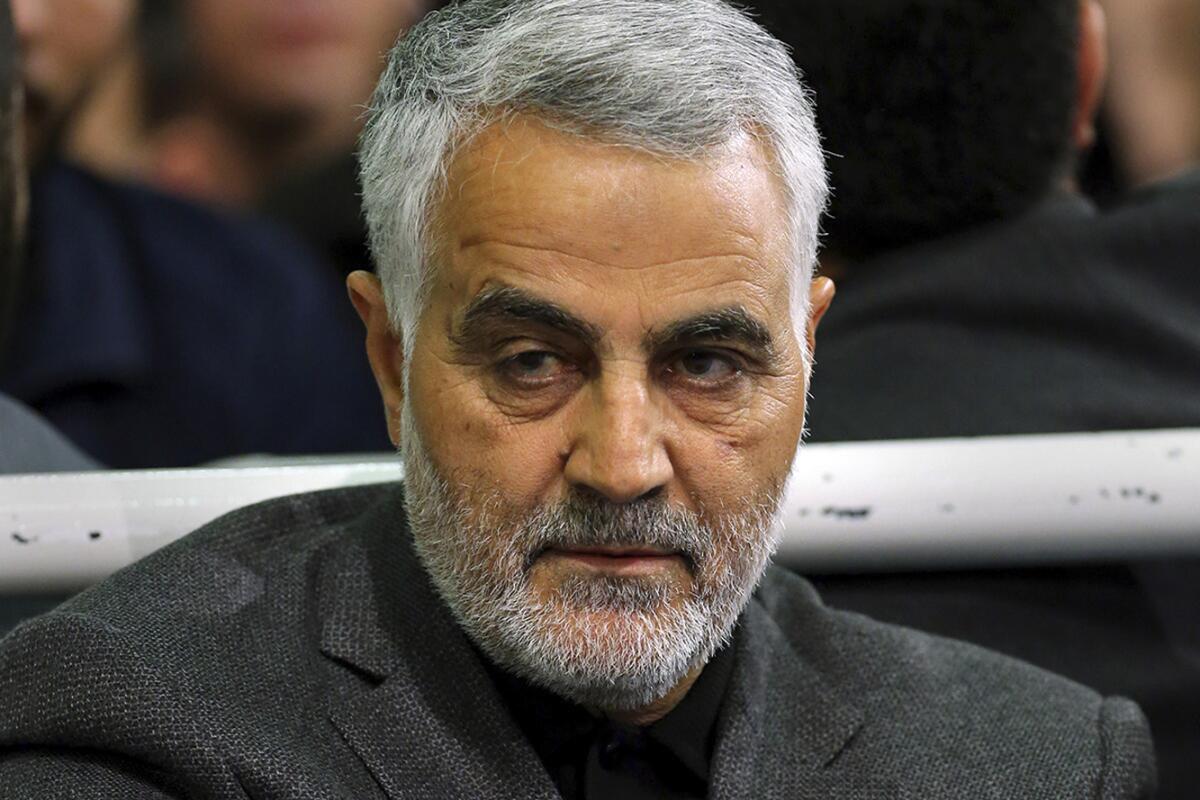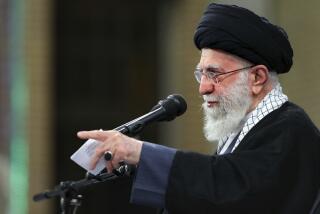Marking a foe for death, living with the consequences: Exactly what rules apply?

- Share via
WASHINGTON — It was 1943. Across a battle theater of tiny, far-flung Pacific island chains and vast reaches of open ocean, U.S. forces were locked in desperate, bloody warfare with Japanese troops. And American military strategists had Adm. Isoroku Yamamoto, architect of the surprise attack 16 months earlier on Pearl Harbor, in their sights.
In a precisely planned raid, the plane carrying Yamamoto, a twin-engine Mitsubishi bomber, was intercepted and shot down by U.S. fighters over the Solomon Islands, where the Imperial Japanese Navy admiral was conducting an inspection tour of Japanese forces. Accounts from the Japanese search-and-rescue team that made its way to the crash site said Yamamoto’s body was found seated upright, still strapped in, clutching the hilt of a samurai-style sword.
Nearly 77 years later, a senior State Department official briefing reporters on President Trump’s decision to order the targeted killing of a top Iranian military commander, Gen. Qassem Suleimani, chose to cite that World War II-era case as a precedent, characterizing the two strikes as preemptive actions meant to save American lives.
“It’s shooting down Yamamoto in 1942,” the official said Friday, slightly off on the date of what was dubbed “Operation Vengeance,” and omitting — crucially — the fact that the United States and Japan were in a declared war at the time. “Jesus, do we have to explain why we do these things?” he said.
Congressional Democrats, human rights groups, some legal experts and several European allies contend that the answer to that is yes. And Suleimani’s slaying has intensified debate in domestic and international legal circles over when extrajudicial killings of adversaries can be justified, particularly in the netherworld between wartime and peacetime.
Behind the headlines and chyrons and pinging of news alerts lies a question long parsed by moral philosophers and depicted in classical literature: whether there can ever be meaningful agreement on the rules of marking a foe for death.
“The broad context really goes back to ancient ethics — outside war, is killing justified?” said Hille Haker, an ethicist in the theology department of Loyola University Chicago. “Because we can do it, we do it.”
The Trump administration has not yet made entirely clear the legal reasoning behind killing Suleimani, whose targeting was highly unusual in light of his stature as a senior official of a sovereign state — unlike nonstate actors such as Osama bin Laden, the Al Qaeda leader killed by U.S. commandos in 2011, or Abu Bakr Baghdadi, the Islamic State chieftain who blew himself up as American troops closed in on him in October 2019.
But some consider the distinction between figures such as Suleimani and Bin Laden to be largely academic. The Quds Force, the elite Iranian military contingent under Suleimani’s command, was branded a terrorist organization last year by the Trump administration, the first such designation for an official apparatus of a foreign government. The 62-year-old general is blamed for masterminding the deaths of hundreds of American troops in Iraq, and engineering, through a lethal network of Iran-linked proxy forces, tens of thousands of civilian fatalities in a crescent stretching from Yemen to Syria.
By both law and custom, even highly adversarial nations refrain from killing one another’s elected or appointed officials, since the result would otherwise be anarchy. The last possibly comparable case of a preemptive U.S. move against a foreign leader was in 1986, when then-President Reagan launched strikes against Libya. The target was widely suspected to have been the North African country’s longtime dictator, Moammar Kadafi, but he was not among the several dozen people killed.
The Trump administration holds that the strike targeting Suleimani was legally permissible under an act of Congress in 2002 that authorized the invasion of Iraq. Senior Trump aides also said the killing was within the bounds of the president’s broad constitutional powers.
“We had the right to self-defense,” the president’s national security advisor, Robert C. O’Brien, told reporters hours after the strike.
And Secretary of State Michael R. Pompeo suggested the U.S. could also seek to kill other Iranian decision makers.
But critics were quick to poke holes in that. Agnes Callamard, the United Nations’ special rapporteur on extrajudicial executions, said the killings of Suleimani and several others in his convoy “most likely” violated international law, which sometimes diverges.
“To be justified under international human rights law, intentionally lethal or potentially lethal force can only be used where strictly necessary to protect against an imminent threat to life,” Callamard wrote in a Twitter thread Friday.
Pompeo made a point of repeatedly using the word “imminent” to characterize the threat to American lives posed by Suleimani. But the administration, claiming a need for operational secrecy, has kept a tight lid on any details supporting its contention that the threat was immediate and credible.
Seeking to quell skepticism about its motives and reasoning, the White House late Saturday sent Congress a formal notification of the strike under the War Powers Act, as required by law. But the document was classified, and House Speaker Nancy Pelosi (D-San Francisco) said it “raises more questions than it answers.”
To bolster the characterization of urgent peril to Americans, Trump aides have pointed to Suleimani’s travel to Baghdad, saying he was actively plotting fresh attacks with militia chieftains in Iraq. Fighters aligned with Iran carried out a series of recent attacks, including the rocket assault on a U.S. base in northern Iraq in late December, killing a U.S. contractor, and last week’s breaching of the gates of the U.S. Embassy in Baghdad.
Yet Suleimani was also in the country on official business, due to meet with Prime Minister Adel Abdul Mahdi, the Iraqi leader said Sunday.
The fact that the administration has not yet detailed its legal reasoning, or provided concrete proof of an imminent threat, does not mean a case can’t be made for the killing, at least under U.S. law, said Scott Anderson, a former State Department advisor who writes for the Brookings Institution’s Lawfare blog.
“They are not completely out on a wire,” he said. “It seems like the executive branch could make the argument they need…. They have a legal footing — I don’t know how great it is.”
Democratic lawmakers, who vehemently insist that select members should have been notified in advance of a strike that could trigger a wider confrontation with Iran, bemoan the diminishing degree of congressional oversight on waging war in the nearly two decades that have elapsed since the Sept. 11 terrorist attacks in New York City and Washington.
Some legal experts point to the erosion of an executive order in place since the late 1970s — made partly in response to the explosive disclosure of CIA attempts to kill figures like Cuba’s Fidel Castro — banning assassinations in peacetime.
“Our country has, quite self-consciously, given one person, the President, an enormous sprawling military and enormous discretion to use it in ways that can easily lead to a massive war,” Harvard law professor Jack Goldsmith, who served in the Justice Department under President George W. Bush, wrote on Twitter last week. “That is our system: one person decides.”
Whether or not the Suleimani killing was legally justifiable, some critics said, the more urgent question is whether potentially dire and long-lasting consequences were thought through ahead of time.
“One reason we don’t generally assassinate foreign political officials is the belief that such action will get more, not less, Americans killed,” Democratic Sen. Chris Murphy of Connecticut wrote on Twitter hours after the Pentagon announced the killing.
Sentiment surrounding the lethal targeting of overseas adversaries has not always broken down neatly along partisan lines. During his time in office, President Obama ordered unprecedented numbers of drone strikes against suspected Islamic militants in South Asia and the Middle East. In one of the most controversial of those, he authorized the killing in 2011 of an American citizen, Anwar Awlaki.
Some close American allies have embraced the practice of targeted killings. Israel in the 1970s embarked on a clandestine campaign of hunting down Palestinian militants it held responsible for the slaughter of Israeli athletes at the 1972 Munich Olympics. In the early 2000s, it went public with its killings of prominent militant figures, including the pinpoint missile strike in 2004 that incinerated Hamas spiritual leader Ahmed Yassin in his wheelchair.
At the time, Israel weathered heavy international criticism, but also underwent some quiet internal debate about the corrosive effect of extrajudicial executions on its own democracy, and whether such “decapitation” strikes truly hampered militant organizations’ reach and abilities in the long run.
Even the semantics of raining death on selected foes are fraught. In the days since Suleimani’s killing, administration officials have bristled at the word “assassination,” although Trump — who often depicts American military exploits in cinematic terms — boasted from his Florida estate of the general having been “terminated.”
“It’s not an assassination,” a senior State Department official said sharply in last week’s briefing when a reporter used the word “assassinated” to characterize the Iranian general’s violent end. “Come on.”
More to Read
Sign up for Essential California
The most important California stories and recommendations in your inbox every morning.
You may occasionally receive promotional content from the Los Angeles Times.













